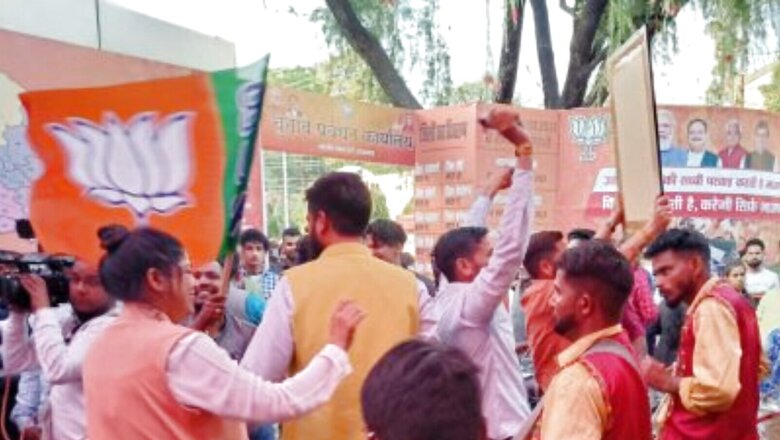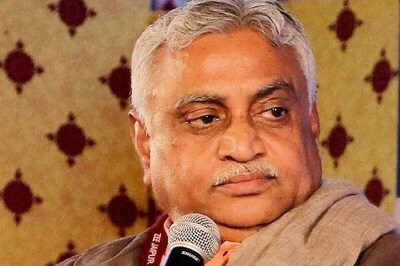
views
In an interview with a popular TV news anchor weeks before India’s smallest state went to the polls, regional news channel Prudent Media’s editor Pramod Acharya characterised his election forecast with the interesting concept of “humiliating victories”.
Pointing out that Goa’s 40 constituencies are tiny – often in the range of just 20,000 voters – and many races were shaping up as multipartite contests, the savvy television anchor predicted that most seats would be settled by narrow margins, and even the most experienced heavyweights would find themselves cut to size.
That is precisely what election results have now revealed, with the incumbent chief minister Pramod Sawant himself coming perilously close to humiliation in his home base in Sanquelim near the Maharashtra border.
Overall, the BJP did narrowly retain power in the first elections following the death of Manohar Parrikar – whose force of personality propelled the party’s emergence to dominate Goan politics throughout the first two decades of the 21st century – but its vote share remains effectively static at just 33 per cent. What is more, if it were not for the divergent energies of the AAP (which finally gained some success with two wins after an abject previous record), and two flamboyant new entries into state politics, the party would almost certainly have crashed to ruin.
The inside story of Goa’s 2022 elections can be easily read in the precise details of the BJP’s “humiliating victories”. One especially illustrative example is the seat at Canacona, where three losing candidates (from the Congress and two Independents) averaged over 5,000 votes, and another 1,000-plus each went to the Trinamool Congress and the Revolutionary Goans, but Ramesh Tawadkar emerged the “victor” having garnered precisely 9,063 votes out of 29,132.
This kind of costly “vote-splitting” had been warned against by several analysts, after the TMC made its noisy entry into the tiny coastal state on the heels of Mamata Banerjee’s dramatic defeat of the BJP in West Bengal last year. Right before the election day on February 14, the Council for Social Justice and Peace of the Catholic church put it starkly: “The peculiarity this time is that there are many choices; parties with national ambitions are here to increase their vote percentages, so as to gain national recognition, even by recklessly splitting secular votes.”
In the end, that’s precisely what happened, and the numbers are undeniable. For example, in the crucial North Goa constituency of Mapusa, the INC and the TMC candidates cleaved apart a comfortable anti-incumbency majority, which allowed the notably unpopular dynast Joshua de Souza to squeak through. Also significant is Navelim in the heart of South Goa, where Ulhas Tuenkar of the BJP won after tallying just 24.2 per cent of votes, with the TMC close behind (22.2 per cent) followed by the INC (17.8 per cent) and the NCP (12.2 per cent).
These kinds of pyrrhic victories up and down their candidate list have left the BJP dramatically diminished, and chief minister Pramod Sawant is likely to retake his office with a prominent target on his back. Instead of a disciplined roster of cadres, he will continue to sit atop an unruly agglomeration of power-hungry individuals with their own support bases that owe little to the party machinery. This is especially true of Parrikar’s successor in the Panjim constituency, where the controversial Atanasio “Babush” Monserrate has already accused karyakartas of trying to defeat him via Utpal Parrikar, the late CM’s son who ran as an Independent candidate.
Monserrate and his wife Jennifer – who barely retained the family fiefdom of Taleigao – constitute just one unpredictable centre of gravity in the current Goa BJP. Yet another wildcard is Vishwajit Rane – who defected to the BJP only in 2017 – and his wife Divya, who inherited her seat from the family patriarch and Congress veteran Pratapsingh Rane. Similarly, there are several others who are notably shakily in Sawant’s fold, including Govind Gaude and Rohan Khaunte, both of whom were already successful Independent MLAs before being forcibly strong armed into the BJP.
These are not the makings of stable governance, but the BJP also faces the additional complication of revitalised opposition, including several debutant MLAs of exceptional calibre after a long drought of new talent dating back to the entry of Manohar Parrikar himself over 25 years ago. Amongst these is high court lawyer Carlos Alvares Ferreira (the state’s former Advocate General) of the Congress, and merchant seaman Captain Venzy Viegas of the AAP, who has most likely ended the career of ultra-colourful five-time legislator and former chief minister Churchill Alemao.
ALSO READ | AAP is Replacing Congress. It’s about Time to Say RIP Grand Old Party
Viegas’s success in Benaulim, along with that of Cruz Silva in Velim, gives the AAP its first two MLAs in Goa on the party’s third campaign effort. Their victories indicate Goa’s still-unquenched appetite for new options, which is one of the most important trends to emerge from these elections, in what is widely considered a bellwether state pointing the direction for broader Indian aspirations. What we can recognise is that Goans wanted an end to status quo, and seized upon every available means to achieve it by scattering votes very widely, even casting 1.12 per cent of them for NOTA.
In this regard, the greatest shock in Goa’s 2022 elections landscape is the meteoric emergence of nativist politics as epitomised by the Revolutionary Goans party. From being limited to creating a ruckus on social media, this brand-new outfit which declares its intention to “fight for our own existence in our own land” has catapulted itself all the way into the state legislature, after its 28-year-old candidate Viresh Borkar sneaked victory in St. Andre by just 76 votes over four-time legislator Francisco Silveira (who had defected to the BJP in 2019).
Despite filling its slate with entirely unknown candidates with zero track records, RG managed to rack up thousands of votes and make the decisive difference in several different constituencies including Sanquelim, where Sawant would have lost without it siphoning 742 votes away from his main contender, Dharmesh Saglani of the Congress. That message will not be lost on the newly re-elected CM of Goa, and we can expect his administration to tack quickly to policies of xenophobia and exclusion as his first strategy to win back mass support.
The writer is co-founder and co-curator of the Goa Arts + Literature Festival. The views expressed in this article are those of the author and do not represent the stand of this publication.
Read all the Latest Opinion News and Breaking News here




















Comments
0 comment